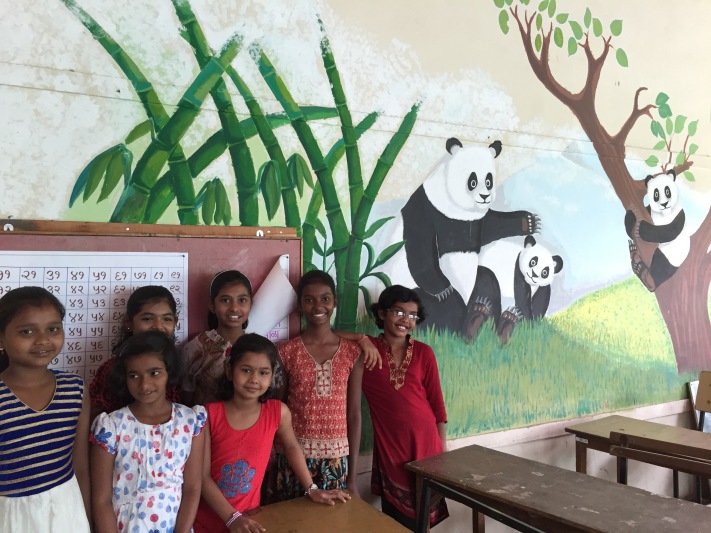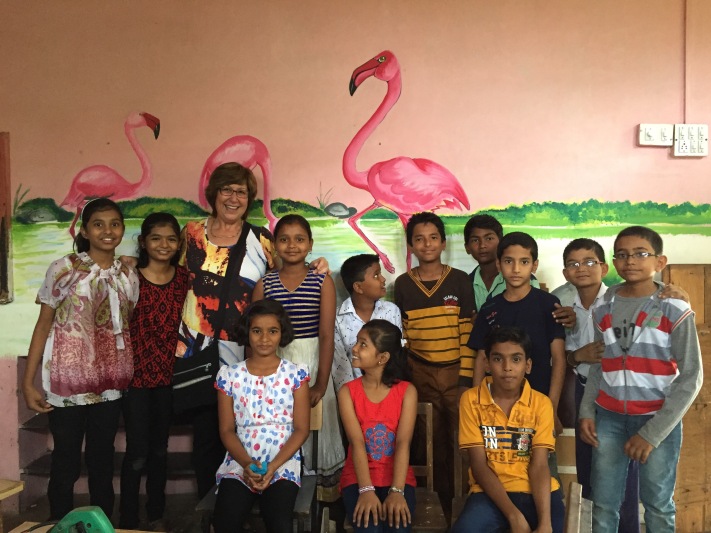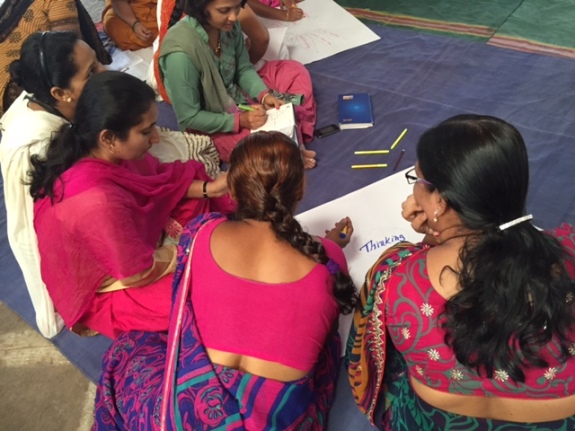Travelling and spending time with family means a few weeks away from social media.
This is a moving guest post by Clive for my series on learning in different contexts. It first appeared at his blog, Clive Sir, a month ago and he agreed to let me post it whenever I liked. As I’m still away from home and not writing posts, it seems like a good time to share it…
I had a chat with someone the other day, talking about teaching styles. It brought back memories of my time in India, circumstances when my student-centric approach broke down.
 We had a lad I shall call Aneesh. About ten years old, he was the son of one of the traders down on the beach. The NGO I was working for had encouraged his parents to send Aneesh to school rather than have him work in their shop. For parents it’s never a case of simply finding a public school to take their children. They have often missed so much schooling that the kids fail the admissions tests. Families are then, usually, left to their own devices to seek private education. In families where little importance is attached to education, where the cost of books is significant, and where the child brings in some income, they mostly don’t bother. My organisation had its own school and provided books, transport, food and clothing, totally free of charge. It paid parents a small fee to compensate for lost income and the children received a small allowance for each day attended, as an incentive. The idea was that they would be brought up to speed over a year or so. The organisation would then fight to get them placed in mainstream publicly-funded school, while continuing to support them by covering all incidental costs. The parents would justify it in terms of doing the organisation a favour: by supplying their children in return for some money the NGO could continue to exist.
We had a lad I shall call Aneesh. About ten years old, he was the son of one of the traders down on the beach. The NGO I was working for had encouraged his parents to send Aneesh to school rather than have him work in their shop. For parents it’s never a case of simply finding a public school to take their children. They have often missed so much schooling that the kids fail the admissions tests. Families are then, usually, left to their own devices to seek private education. In families where little importance is attached to education, where the cost of books is significant, and where the child brings in some income, they mostly don’t bother. My organisation had its own school and provided books, transport, food and clothing, totally free of charge. It paid parents a small fee to compensate for lost income and the children received a small allowance for each day attended, as an incentive. The idea was that they would be brought up to speed over a year or so. The organisation would then fight to get them placed in mainstream publicly-funded school, while continuing to support them by covering all incidental costs. The parents would justify it in terms of doing the organisation a favour: by supplying their children in return for some money the NGO could continue to exist.
Aneesh was a real character. Highly popular with his fellow students, he was always making them laugh. Somehow, miraculously, the organisation got him immediately placed in a local English-medium public school. Maybe because he bluffed his way in or for some other reason, whatever, he got in.
The policy was that all such kids would come back to us for tuition after the school day. Being one of our “tuition kids” had several advantages: we would get to hear how they were doing at school and what they were struggling with, so we could then focus on the weak areas. Coming from poor families, these children were frequently bullied; by giving them the opportunity to talk about it we could try to do something to help, even if it was only to take them back into our day-time school. Finally, home environments were often not conducive to studying or doing homework, maybe because there was no table or space or light, but sometimes because of abusive family members; a few hours in afternoon tuition meant the children got some necessary support.
Anyway, Aneesh struggled badly in all subjects and eventually I was assigned to help him. Language wasn’t a barrier – he and I could communicate quite effectively because his spoken English was good, most likely a result of speaking with tourists in his shop. I concentrated on maths and computing with him and I quickly discovered that he was only surviving because he was copying his neighbours’ work. His friends didn’t mind because he was amusing, always acting the buffoon and mucking about but, in the strict, Victorian-disciplined day school he now found himself, he was no longer getting away with it.
After a week he told me that he was really worried about an imminent computing exam. I had a look at his text-book – it was essentially a learn-by-rote work-book, typical of the way many Indian kids learn. It was pretty dreadful, expecting kids to simply repeat unexplained words and phrases. I could do better. With only a few days till the exam I decided that the most effective way to get him to grasp the concepts was to work one to one, discussing and explaining the things to be covered, and trying to encourage questioning, thinking and understanding. He actually seemed to improve so I thought he’d stand a chance of doing reasonably well.
Aneesh sat it and got his marks back almost immediately. He was very weepy when he showed them to me. What stared out from the sheet, in big, red letters, was “3/25″. Worse, the teacher had written down the page:
“V.V.V.V.V.V.V.V.V.V.V.V.V. Bad.”
I didn’t count them – I was too dismayed. There were probably more. I guess that gives you an idea of the quality of teaching some Indian children encounter. Teachers are not all like that, of course, but the existence of even one is one too many. Pure punishment. Where were the gentle words of encouragement?
After I had calmed down I thought about it some more. What I hadn’t realised was that firstly, in all likelihood, the teacher didn’t understand his subject. He was lazy and was playing safe by following the work-book to the letter. Secondly, the exam followed exactly the same format: words had to be memorised and quoted verbatim. There was no leeway and any understanding was incidental. It didn’t matter what “input” meant, it just mattered that that was the word to be fitted into the blank.
I blame myself. I should have known. I hadn’t made the connection. If I had spent time getting Annesh to repeat and regurgitate the words then he would have passed the test. Educationally a meaningless test, but that was lost on Aneesh and he was the one who mattered.
My recommendation was that Aneesh should be taken out of that school and brought back to us. He was just too weak and had way too much ground to make up. Management didn’t see it like that, driven by the belief that the public school was an opportunity not to be wasted. Perhaps he was better in other subjects but I doubt it. I questioned my ability to help any of the Tuition Kids because I saw no value in working like that. Aneesh was taken away from me and given to a more conventional teacher. They persisted for a few months until after I left India. I heard through the grapevine that he eventually returned to the NGO’s school where he would have received the nurturing he so needed.














 We had a lad I shall call Aneesh. About ten years old, he was the son of one of the traders down on the beach. The NGO I was working for had encouraged his parents to send Aneesh to school rather than have him work in their shop. For parents it’s never a case of simply finding a public school to take their children. They have often missed so much schooling that the kids fail the admissions tests. Families are then, usually, left to their own devices to seek private education. In families where little importance is attached to education, where the cost of books is significant, and where the child brings in some income, they mostly don’t bother. My organisation had its own school and provided books, transport, food and clothing, totally free of charge. It paid parents a small fee to compensate for lost income and the children received a small allowance for each day attended, as an incentive. The idea was that they would be brought up to speed over a year or so. The organisation would then fight to get them placed in mainstream publicly-funded school, while continuing to support them by covering all incidental costs. The parents would justify it in terms of doing the organisation a favour: by supplying their children in return for some money the NGO could continue to exist.
We had a lad I shall call Aneesh. About ten years old, he was the son of one of the traders down on the beach. The NGO I was working for had encouraged his parents to send Aneesh to school rather than have him work in their shop. For parents it’s never a case of simply finding a public school to take their children. They have often missed so much schooling that the kids fail the admissions tests. Families are then, usually, left to their own devices to seek private education. In families where little importance is attached to education, where the cost of books is significant, and where the child brings in some income, they mostly don’t bother. My organisation had its own school and provided books, transport, food and clothing, totally free of charge. It paid parents a small fee to compensate for lost income and the children received a small allowance for each day attended, as an incentive. The idea was that they would be brought up to speed over a year or so. The organisation would then fight to get them placed in mainstream publicly-funded school, while continuing to support them by covering all incidental costs. The parents would justify it in terms of doing the organisation a favour: by supplying their children in return for some money the NGO could continue to exist.



